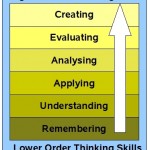My MET Assessment Experience
This looks like a very interesting topic! I am quite passionate about the topic of assessment, as I am experiencing first-hand, the difference in product-based assessment vs traditional assessment formats in our MET program. As I am completing the courses and creating a variety of products, my colleagues in other Masters programs are cramming for exams – we know how much we retain from those experiences!
My products for assessment purposes so far have included: videos, concept maps, wikis, blogs, Picasso creations, and yes, a paper or two. But overall, I find this assessment to be authentic, engaging and without a doubt, challenging. I realize that to gather a true understanding of a student’s learning, we need triangulation – a combination of product, observation, and conversations – but the product has so much more meaning than the pencil and paper quiz and exam. When I think of the revised Blooms taxonomy, creation is at the highest order of thinking, so product based assessment is more challenging than most other assessments.
 Creating is the highest form of learning and product based assessment ensures that this higher order thinking takes place
Creating is the highest form of learning and product based assessment ensures that this higher order thinking takes place
http://edorigami.wikispaces.com/Bloom%27s+-+Introduction
I have taken far too many courses in the past, where regurgitation of my knowledge accumulation was the goal. I can memorize all that is needed, but it is in performance or creation of an authentic product, that I learn the most.
Brenda
Posted in: Week 10: Product-Based Assessments
Doug Smith 6:32 pm on November 7, 2011 Permalink | Log in to Reply
Thanks for the post Brenda. I think you hit on some key terms there, when you talk about authenticity, engaging and challenging. As I was coming home from work today, I was reflecting upon some marking I had just completed. I decied to assess a unit in junior science (chemistry) by using a concept map, as opposed to making the students memorize parts of the periodic table. So I feel your pain with regurgitation and hope that we can continue to discover and explore different aspects of product based assessment, and what it means for our ability to offer this to the EVM.
cheers
Doug
Kristopher 5:51 am on November 8, 2011 Permalink | Log in to Reply
Hi Brenda,
While reading your post, the word balance was becoming more and more bold in my mind, and low and behold as I continued you came to triangulation. Triangulation is a great was to describe the relationship that different types of learning/assessment must build in a learning environment. I have found that the MET program has had a decent combination of product-based assignments (like this course’s assignment 2), as well a huge value placed on contributions to discussion, and finally an essay or two along the way.
Thanks for the thoughts,
Kristopher
verenanz 12:11 pm on November 8, 2011 Permalink | Log in to Reply
Hi Brenda,
I appreciated your links to Bloom’s Taxonomy. Many times PB learning is criticized for not offering “real” learning outcomes. Like you, I enjoy creating project as part of my learning. You mentioned authentic learning, and I think that is such a KEY piece of PBA. Have you checked out the video about PBA using mobiles and authentic learning
http://edtalks.org/video/tools-learning-mobile-phones-and-authentic-learning-tasks
I got it from nic peachy’s tech portal….:)
http://www.scoop.it/t/learning-technology?page=2
Thank you for your great IPad App site as well! http://appitic.com/ It is phenomenal and it provides some great examples of how to integrate Apps into any class, project or product…..
Verena:)
kstooshnov 9:22 pm on November 9, 2011 Permalink | Log in to Reply
Hi Brenda,
Thank for mentioning Bloom in your post, and the movement from remembering (or regurgitating) to higher levels of evaluating and creating. I just saw an excellent TED talk, from last year (so it is probably old hat by now), with Sugata Mitra explaining child-driven education where most of the time, he would set up an impossible task for children, not give full instructions, and walk away. In a couple of months, he’d return to find the children had nearly mastered the task set out for them, and continued to seek more challenging work. It seems like they are knocking out the bottom base of Bloom’s Taxomony, and finding ways of applying knowledge on their own. While it seems to be a success story for product-based learning, I find it a bit worrisome that students are less curious about the what’s and how’s, even if they are capable of thinking at the why and why not level.
Kyle